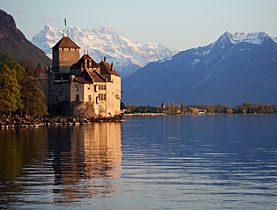
Byron’s picture-postcard castle gets a makeover

What do Lord Byron, Salvador Dali and Queen Elizabeth II have in common? They have all visited Switzerland's most popular historic monument – the Château de Chillon.
Last week Swiss President Pascal Couchepin joined the famous list when he inaugurated the “new-look” medieval castle on Lake Geneva, where the presentation has been revamped to better show off its thousand-year-old history.
Even on a grey cloudy day in March, the 11th-century castle, built on a rocky spur on the eastern shore of the lake, remains one of Switzerland’s most evocative sights. It’s an image pinned to thousands of walls around the world.
With its towers reflected in the deep silver waters and the dramatic snowy Dents du Midi peaks as a backdrop, it is easy to see why Byron and millions of others who have passed this way have been enchanted by the fortress.
“There are lots of very beautiful castles in Switzerland, but [Chillon’s] architecture and setting, with lake and mountains and possibility to access by boat or on foot, is unique,” the castle’s new director, Jean-Pierre Pastori, told swissinfo.
Like Zermatt’s Matterhorn, Lucerne’s Chapel Bridge and Geneva’s Jet d’Eau, the Château de Chillon has become a “must-see” tourist stop-off.
Sleeping beauty
But despite its iconic status, global tourism trends have forced Chillon to keep up with the times and give itself a more youthful image.
With around three-quarters of visitors from overseas, events such as the September 11 attacks and the SARS (severe acute respiratory syndrome) pandemic had a massive impact on visitor numbers.
Between 1990 and 2003, the annual record of 350,000 visitors fell by 100,000. It has since climbed back up to 320,000 last year, mainly thanks to private events, but the drop was sufficient to shake those running the castle out of their slumber.
“It was a castle that was asleep – everyone was sleeping, the management, marketing, everyone,” said local guide Eric-Alain Kohler.
Since 2003, the castle, which belongs to canton Vaud, has been managed by a private foundation, which has put in place an ambitious long-term strategy.
The first fruit of “Chillon 2010” is the new SFr1.5-million ($1.5 million) tour resources, which Couchepin and 400 local dignitaries inaugurated on March 13.
“It’s not Disneyland”
Despite its idyllic setting, in the past visitors complained the castle was empty, and information was lacking or not very well displayed, explained deputy director Marta Dos Santos.
“We hadn’t done much in 80 years, apart from moving around some of the furniture,” she admitted.
As part of the changes, out go the simple photocopied brochures and in come iPod audio-guides in eight languages and discreet hi-tech graphic information panels, recounting life in the castle and other aspects of military history, architecture and archaeology.
“It’s not Disneyland or McDonald’s,” explained Michel Etter, who helped design the itinerary and rebuild the castle’s collection of historical objects.
“It was very important that we respected the buildings.”
Mediaeval history purists will therefore be delighted to know that the exterior remains untouched.
However, the foundation is not stopping there. “Chillon 2010” includes plans to develop visitor infrastructure – ticket office, cafeteria and gift shop – and additional improvements to the tour content.
It also wants to develop Chillon as a cultural site. As well as hosting two Montreux Jazz Festival concerts in summer and classical concerts in September, there are plans to put on plays and to publish works inspired by the site, a historical guide and a CD of medieval music.
swissinfo, Simon Bradley at Château de Chillon
Built for the Dukes of Savoy, the Château de Chillon’s origins probably go back to the 11th century, but its present appearance dates from the 13th century. The first fortress was built to guard the road from Avenches in Switzerland to Italy, which crossed the Grand St Bernard Pass after skirting Lake Geneva.
In 1536 the castle was captured by the Bernese, and from then until 1798 it was the seat of the region’s Bernese bailiffs.
The centre of court life, the castle was also used as a prison. Its most famous prisoner was François Bonivard, imprisoned there from 1530 to 1536 for political incitement.
Chillon is an inexhaustible source of inspiration, especially to writers and artists. The English poet Lord Byron immortalised Bonivard in “The Prisoner of Chillon”, which he wrote in Ouchy, near Lausanne, in 1816.
Jean-Jacques Rousseau, Alfonso Lamartine, Victor Hugo and Alexander Dumas have also celebrated the castle and its beauty. The idyllic setting also inspired the 19th-century painters of the “Small Swiss Masters” school, whose small format landscape engravings were produced in series like modern postcards.
The Château de Chillon is Switzerland’s most popular historic monument.
In 2007 some 320,000 people visited the castle (including 275,600 paid entries);
Three-quarters of all visitors are from abroad (United States: 10.7%; France: 7.2%; Germany: 6.4%; Britain: 6.3%; Eastern Europe: 6%; Japan: 5.6%; China: 4.4%);
Annual operational budget: SFr4 million;
There are 40 staff of whom 20 are full time.

In compliance with the JTI standards
More: SWI swissinfo.ch certified by the Journalism Trust Initiative






























You can find an overview of ongoing debates with our journalists here . Please join us!
If you want to start a conversation about a topic raised in this article or want to report factual errors, email us at english@swissinfo.ch.